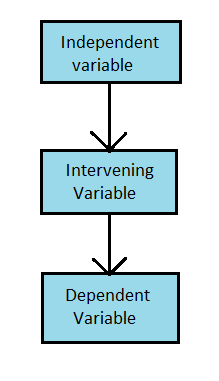An intervening variable in statistics and psychology is a variable that acts as the link between the independent and dependent variables. The independent variable causes a change in the intervening variable, which in turn causes a change in the dependent variable.

The intervening variable is also called the mediating variable. This is because as we saw above it acts as the casual link, that is, it “mediates” between the dependent and the independent variables.
The intervening variable is generally hard to quantify and is hence not usually taken to be part of our statistical model.
Examples of Intervening Variables:
Some of the most common examples of intervening variables are:
Example 1: Time Spent Studying and Marks Obtained
Suppose we are interested in the relationship between the following two variables – “Time spent studying for the exam” and “Marks obtained in the exam”.
Here the time spent studying is the independent variable. If more time is spent studying then better marks are obtained. Hence, the marks obtained are the dependent variable.

Here the intervening variable is – “The gain in understanding of the subject”. This is because if we spend more time studying, we gain a better understanding of the subject which in turn causes us to obtain better marks in the exam.
Notice that in the above example, the independent and the dependent variables are easy to quantify and measure whereas it is hard to quantify the intervening variable. It is difficult to assign a numerical value to a person’s understanding of a subject.
The above observation is also true in general. The independent and dependent variables are quantifiable whereas the intervening variable is qualitative.
Example 2: Salary Increase and Job Productivity
It is well known that job productivity in the corporate world is correlated to the increase in salary given to the worker.
A higher rise in salary leads to an increase in job productivity. Here, “Increase in Salary” is the independent variable, and “Job Productivity” is the dependent variable.
The intervening variable, in this case, is “Motivation”. An increase in salary leads to an increase in motivation for the employee which leads to gains in productivity.
Motivation is often considered to be an intervening variable since it is an emotional response that is often responsible for connecting the independent and dependent variables.
Example 3: Parental Income and Child Income
There is a very high correlation between the income of a parent and the income of their children. Generally, children from high-income households tend to have a higher monthly income.
Here, one of the intervening variables could be Education. Parents with high incomes can afford better resources and spend more on their children’s education. Better education for the child automatically leads to an increase in the income of the offspring.
Example 4: Country of Birth and Life Expectancy
It is an empirical fact that some countries have a higher average life expectancy than others. It is not the case that people in one country tend to have a naturally shorter lifespan than others. Hence, we must introduce intervening variables to understand the disparity in lifespans.
One of the possible intervening variables could be the “Quality of Healthcare” available in the country. One of the reasons that Japan has a high average life expectancy is because of the high quality of healthcare that the government provides to its citizens.
Other lower-income countries may not be able to provide good healthcare to their citizens which might lead to a lowering in life expectancy.
Intervening Variables vs Confounding Variables:
Intervening Variables must not be confused with confounding variables. An intervening variable only affects the dependent variable whereas a confounding variable can affect both the dependent as well as the independent variable.
An example of a confounding variable consider the relationship between the “Weight” and “Blood Pressure” of an individual. Here, the variable “Amount of Exercise” is a confounding variable. An individual who exercises more is expected to have a lower weight. Exercise is also known to have an effect on blood pressure.
Since the amount of exercise has an effect on both the dependent and the independent variable it is a confounding variable and not an intervening variable.
What does the presence of an Intervening Variable Signify?
The presence of an intervening variable signifies that the relationship between the dependent and the independent variable cannot be fully understood unless we understand the effect of the intervening variable. The intervening variable causes a change in the value of the dependent variable and links the independent and dependent variables.
The intervening variables are important to study because they improve our knowledge of the causes that affect the dependent variables. Hence by controlling the intervening variable we can obtain control over the dependent variable.
The intervening variables are of less significance in statistical models where they are not included because of the difficulty in measuring them.
There is no systematic method to follow in order to identify intervening variables. The researcher must use his knowledge of the situation under study to try and identify what might be acting as the causal link between the two variables.